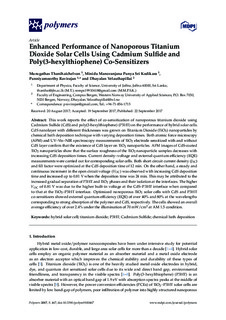| dc.contributor.author | Thanihaichelvan, Murugathas | |
| dc.contributor.author | Sri Kodikara, Minidu Manoranjana Punya | |
| dc.contributor.author | Ravirajan, Punniyamoorthy | |
| dc.contributor.author | Velauthapillai, Dhayalan | |
| dc.date.accessioned | 2019-03-28T08:22:53Z | |
| dc.date.available | 2019-03-28T08:22:53Z | |
| dc.date.created | 2017-12-18T19:46:59Z | |
| dc.date.issued | 2017 | |
| dc.identifier.citation | Thanihaichelvan, M., Kodikara, M., Ravirajan, P., & Velauthapillai, D. (2017). Enhanced performance of nanoporous titanium dioxide solar cells using Cadmium Sulfide and poly(3-hexylthiophene) co-sensitizers. Polymers, 9(12). | nb_NO |
| dc.identifier.issn | 2073-4360 | |
| dc.identifier.uri | http://hdl.handle.net/11250/2592078 | |
| dc.description.abstract | This work reports the effect of co-sensitization of nanoporous titanium dioxide using Cadmium Sulfide (CdS) and poly(3-hexylthiophene) (P3HT) on the performance of hybrid solar cells. CdS nanolayer with different thicknesses was grown on Titanium Dioxide (TiO2) nanoparticles by chemical bath deposition technique with varying deposition times. Both atomic force microscopy (AFM) and UV–Vis–NIR spectroscopy measurements of TiO2 electrode sensitized with and without CdS layer confirm that the existence of CdS layer on TiO2 nanoparticles. AFM images of CdS-coated TiO2 nanoparticles show that the surface roughness of the TiO2 nanoparticle samples decreases with increasing CdS deposition times. Current density–voltage and external quantum efficiency (EQE) measurements were carried out for corresponding solar cells. Both short circuit current density (JSC) and fill factor were optimized at the CdS deposition time of 12 min. On the other hand, a steady and continuous increment in the open circuit voltage (VOC) was observed with increasing CdS deposition time and increased up to 0.81 V when the deposition time was 24 min. This may be attributed to the increased gradual separation of P3HT and TiO2 phases and their isolation at the interfaces. The higher VOC of 0.81 V was due to the higher built-in voltage at the CdS–P3HT interface when compared to that at the TiO2–P3HT interface. Optimized nanoporous TiO2 solar cells with CdS and P3HT co-sensitizers showed external quantum efficiency (EQE) of over 40% and 80% at the wavelengths corresponding to strong absorption of the polymer and CdS, respectively. The cells showed an overall average efficiency of over 2.4% under the illumination of 70 mW/cm2 at AM 1.5 condition. | nb_NO |
| dc.language.iso | eng | nb_NO |
| dc.publisher | MDPI | nb_NO |
| dc.rights | Navngivelse 4.0 Internasjonal | * |
| dc.rights.uri | http://creativecommons.org/licenses/by/4.0/deed.no | * |
| dc.subject | hybrid solar cell | nb_NO |
| dc.subject | titanium dioxide | nb_NO |
| dc.subject | P3HT | nb_NO |
| dc.subject | Cadmium Sulfide | nb_NO |
| dc.subject | chemical bath deposition | nb_NO |
| dc.title | Enhanced performance of nanoporous titanium dioxide solar cells using cadmium sulfide and poly(3-hexylthiophene) co-sensitizers | nb_NO |
| dc.type | Journal article | nb_NO |
| dc.type | Peer reviewed | nb_NO |
| dc.description.version | publishedVersion | nb_NO |
| dc.rights.holder | © 2017 by the authors | nb_NO |
| dc.subject.nsi | VDP::Matematikk og Naturvitenskap: 400::Fysikk: 430 | nb_NO |
| dc.source.volume | 9 | nb_NO |
| dc.source.journal | Polymers | nb_NO |
| dc.source.issue | 10 | nb_NO |
| dc.identifier.doi | 10.3390/polym9100467 | |
| dc.identifier.cristin | 1529293 | |
| cristin.unitcode | 203,2,0,0 | |
| cristin.unitname | Avd for ingeniørutdanning og økonomifag - Bergen | |
| cristin.ispublished | true | |
| cristin.fulltext | original | |
| cristin.qualitycode | 1 | |

